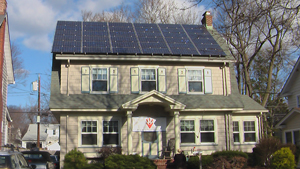 Homegrown electricity could be one ingredient used to combat the 21st century’s expected energy crunch, easing the load on electrical grids with a system called “net metering,” now legal in 34 states. Net metering works by enabling electricity customers who make their own power to actually sell to, as well as buy from, their utility companies…
Homegrown electricity could be one ingredient used to combat the 21st century’s expected energy crunch, easing the load on electrical grids with a system called “net metering,” now legal in 34 states. Net metering works by enabling electricity customers who make their own power to actually sell to, as well as buy from, their utility companies…
If participants produce enough electricity to meet their own needs, they won’t draw any from the grid. They also wouldn’t be billed for power they don’t use. If they produce a surplus, they can sell it back to a utility, which either sends them a check or, more typically, credits their account. Most customers generate their power with nonpolluting methods that include solar panels or wind turbines.
About 25,000 Americans generate their own electricity, according to the U.S. Department of Energy, and of those, more than 15,000 participate in net metering, according to the New York-based Network for New Energy Choices (NNEC).
California has the most, with about 13,000 customers signed up for net metering as of 2004, the last year for which data were available. New Jersey has the next most, with just over 300. Many of the other eligible states have fewer than 100 or none at all.
Businesses also participate. For example, delivery giant FedEx Corp. runs a solar-powered, net-metered hub at Oakland International Airport.

The NNEC released a report in November that graded each state that allows net metering. The report, “Freeing the Grid,” concluded that states’ confusing laws and poor public-information campaigns have kept more people from the practice. If lawmakers streamlined the tangle of rules surrounding net metering and better educated customers about it, more homeowners and businesses would install their own power-generation equipment and use the two-way link with power grids, according to the report.
U.S. Senate Majority Leader Harry Reid (D-Nev.) supports legislation that would further expand net metering, a spokesman said. Senate Democrats included net metering in an energy bill that didn’t pass last year. They expect to include it as part of their energy agenda for the 110th Congress.
The cost for outfitting a regular house for net metering varies depending on local laws. One couple in New Jersey installed a solar-panel system this year worth about $50,000, but after state subsidies and rebates, ended up paying about $17,000, according to the NNEC. After seven years, they will have saved approximately that much in energy costs and all the electricity they use thereafter will be free, said NNEC Executive Director Chris Cooper.
Criticism of net metering comes mostly from electric companies, which say it costs them money and can lead to higher rates for regular customers. The Washington, D.C.-based Edison Energy Institute, the nation’s largest association of electric companies, said in a November press release that if fewer customers pay regularly for power but still retain the option to use the grid, traditional customers have to bear more of the cost for delivering electricity and administering the networks.
Also, when the issue was being debated December 14 and 15 in Charleston, S.C., officials with the power company Santee Cooper said it could be dangerous for line workers to feed power from homes or businesses to the grid, the Charleston Post Courier reported.
Cooper said that net metering ends up benefiting utilities, customers and the environment, adding that power companies are just wary of its newness.
“They’re like a star baseball hitter who’s always used a wooden bat. You give them a new bat — and even when you give them all the information about the new bat — it’s still difficult for them to hit with it,” Cooper said. “For years they’ve been responsible for providing electricity their way, and it’s the novelty of this issue that’s difficult for them.”
But, Cooper said, power companies should embrace net metering in an era of ever-increasing demands on power grids and a greater political push for renewable energy. He said that every participant off the grid means less strain on utilities, which, in turn, makes delivering electricity to everyone more reliable.
The NNEC report awarded states a letter grade, “A” through “F,” on the effectiveness of their programs.



















